Content
- 1 Varieties and types
- 2 Buddlea david landing and leaving
- 3 Watering buddley
- 4 Buddleya transplant
- 5 Fertilizer for buddley
- 6 Buddleya preparing for winter
- 7 Pruning buddley
- 8 Buddlea david growing from seed
- 9 Propagation of buddley by cuttings
- 10 Diseases and pests
- 11 Distribution history
- 12 Buddley in landscape design
- 13 Varieties for Russian gardens
- 14 Reproduction of Buddley David. Planting and leaving
- 15 What drives growth
- 16 Worth knowing ...
- 17 Budleya David: description
- 18 Gallery: buddleya David (25 photos)
- 19 Varieties and types of budley
- 20 David's buddley flower: planting, reproduction and care
Buddleya is an ornamental shrub that grows mainly in the tropics and subtropics of East Asia, America and South Africa. It includes about 100 species, among which there are also wild-growing herbaceous plants.
The sophistication of the buddleya is known all over the world, thanks to its late and long flowering (from July to October), during which many insects, especially butterflies, flock.
Varieties and types
Buddley of David - a very common species in floriculture, which has become the basis for many garden varieties. It grows in China, rising to 2-3 meters in height, sometimes even turning into a small tree 5 meters high with wide spreading branches.
This plant loves warmth, and therefore we have taken root as a shrub. Leaves are lanceolate, pointed at the ends, dark green above and whitish-yellow below, growing up to 25 cm in length.Dense, up to 40 centimeters in length, inflorescences consist of purple flowers, from which a pleasant honey aroma emanates ... The flowering period begins in late summer and ends in autumn (lasts up to 45 days) when the plant reaches 3 years of age.
The following varieties of David Buddha are most popular:
- Buddleya David Royal Red - with red-purple flowers;
- Buddleya David Pink Delight (pink) - one of the most beautiful varieties with pink flowers.
- Buddleya David Black Knight - with dark purple flowers;
- Buddleya David Empire Blue - the flowers of this variety have a violet-blue color;
- Buddley of David Adonis Blue - with blue-lilac flowers;
- Buddleya David Nano Ash - it is distinguished by bright purple-red, very fragrant flowers that form large tassels at the ends of the stems;
- Buddley of David Harlequin - with fragrant purple flowers and variegated leaves, faceted with a creamy yellow border and the same specks;
- Buddleya David Flower Power - with flowers of an orange-violet hue;
- Buddleya David African Queen - with lush inflorescences of purple, pink and white colors.
Buddleya alternate-leaved grows in the northwest regions of China in open dry places. Thin arcuate shoots of this shrub can reach 4 meters. Leaves taper towards the base, becoming sharp at the apex, dark green above and grayish under the cover of pubescence below. The flowering period, ranging from 20 to 25 days, is characterized by the extraordinary showiness of lilac inflorescences, similar to beautiful garlands.
The garden hybrid of David buddley and globular buddley is known as “Weyer's buddley”. This is a shrub up to 3 meters in height with a dense rounded crown. The leaves are lanceolate, up to 20 cm long, sharp at the top, shine from above, and covered with thick down below. Spherical dense inflorescences consist of small bright flowers from yellow to pinkish-apricot.
Flowering occurs in July-August. The hybrid is frost-resistant - withstands temperatures up to minus 23 ° C. Variety Buddhlea Weier Sangold characterized by small orange-golden flowers gathering in oblong panicles.
Buddleya santana blooms in dark pink colors, sometimes it is also called “buddlea purple”.
to the table of contents
Buddlea david landing and leaving
Planting a buddleya includes several stages. In February, the plant should be pre-planted at home - in boxes or pots. From April to May, the soil is already sufficiently warmed up for planting seedlings in open ground.
Usually, the plant is left in a container when buried so as not to harm the root system. Before the onset of cold weather, they dig it up and move it in special containers for storage in a cool place (the basement will do fine). In order to avoid moisture evaporation, it is better to cover the container with foil, without touching the plant itself.
For the winter, only age specimens of 2, 3 years of experience should remain in the soil, taking into account the fact that frosty winters and light winters with a predominance of thaws are dangerous for buddleya. After winter, the buddleya can be planted again in the open ground in the same spring period. If this is not done, the plant will not have enough moisture in the summer and will need to be watered frequently.
to the table of contents
Watering buddley
Watering should be sufficient to provide moist soil without accumulation of liquid. In the summer, it is also recommended to spray the crowns of bushes with water.
to the table of contents
Buddleya transplant
Budlee transplants are strictly contraindicated. This should be done only in extreme cases, subject to all conditions, namely - spring, evening, rather cool weather. The bush is dug out with the maximum possible amount of soil, without touching the roots, and, after transplanting to a new place, it is watered abundantly, preventing the soil from drying out.
Buddleya can thrive in any soil. The exception is acidic and boggy soil types.
to the table of contents
Fertilizer for buddley
Top dressing with nitrogenous fertilizers must be carried out twice a season - at the end of winter and in the middle of summer. Germination and flowering are perfectly stimulated by fertilizers based on phosphorus and potassium and organic fertilizing.
to the table of contents
Buddleya preparing for winter
To prepare the plant for winter, the bushes are covered with film, peat, dry foliage and the planting area is covered with snow. Frozen twigs are cut in spring, after which the crown is easily restored.
to the table of contents
Pruning buddley
Pruning is very important for all types of buddles. It is recommended to remove all ripe flowers so that the branches are not exposed. In place of one such flower, two may appear, and if this procedure is constantly performed, the flowering of the bush will be very lush.
During planting, the main branches are cut half-length to accelerate the development of young shoots, and weak growths are completely removed. Pruning is best done in March.
to the table of contents
Buddlea david growing from seed
Reproduction of buddley is carried out by seeds and cuttings. From seeds, these plants will sprout up to 2 months, while often only 40% of the total number planted germinates and 50% of new ones die due to high requirements for heat and light. Therefore, buddley is propagated more often by cuttings or ready-made seedlings.
to the table of contents
Propagation of buddley by cuttings
The easiest way is to take apical cuttings from an adult plant in early to mid-summer, cutting off several strong, young stems, removing the lower leaves from them and treating the cutting with a composition to stimulate growth.
The stems prepared in this way are planted in loosened soil, watered and covered with a film until the roots set. Plants propagated by this method will retain all the species characteristics of the variety.
to the table of contents
Diseases and pests
The buddleya has no obvious enemies among the pests. The only one that can be noted is aphids. So spraying should be carried out only in the obvious case of the appearance of this insect.
There are situations when buddleya does not bloom even with the observance of the rules of care and due attention from the gardener.This means that a number of additional measures must be taken to adapt it to the surrounding conditions.
For example, when planting, it will not hurt to place the buddley of David in a sunny location, protected from cold wind gusts. Bushes should grow freely, without blocking each other's access to the sun.
One should also take into account the peculiarity of alternate-leaved buddleia, which consists in the fact that its generative buds are located on the stems of previous years, therefore, if these shoots are damaged, flowering is weak.
Despite the absence of any special requirements for the soil in terms of growth, the quality of flowering directly depends on it. A windless, sunny area with fertile, drained soil with a neutral pH is optimal for planting buddleia.
to the table of contents

A child of the temperate latitudes of three continents - Asia, South America and Africa - buddleya has found countless admirers among gardeners and amateurs of both hemispheres since the end of the 19th century. And how could it be otherwise, if this deciduous shrub gives the joy of flowering 45 days a year, has a wide palette of colors and grows quickly on the sunny side of the garden, without fear (under reliable shelter) twenty degrees of frost.
…
It is interesting that this sprawling shrub with an abundance of tassel-like fragrant inflorescences many other romantic namesrevealing the essence of his nature. So, buddleya is called "autumn lilac" for its resemblance to the gardeners' favorite shrub that blooms in spring. For its honey aroma, it is called "honey bush", and for its indispensable companions during flowering - "a magnet for butterflies." In the English transcription of buddley - butterfly bush, which literally translates as "butterfly bush".
Distribution history
Like many other ornamental plants, buddlea came to the gardens of Europe from England, where its herbarium specimen, sent by a monk named David, was brought from China.
The recipient of the dried original of the new plant was Rene Franchet, who in his description and classification of the specimen showed his respect to his colleague, the botanist Adam Buddl, who lived in the early 18th century. This is how the Latin name for a flowering bush appeared - Buddleja.
Wild plants belonging to the buddleev family are found in South Africa, China and even in the Caucasus. But the man actively “tamed” this shrub to those conditions in which he had never been able to grow, carried out breeding work to increase the height of the bush, increase the flowering time, a variety of colors and the shape of inflorescences.
Over the past hundred years, 150 species of buddlei have been born, including cultivated and hybrid varieties.
Buddley in landscape design
At present, it is a favorite shrub of gardeners in our country, up to Siberia. It harmoniously fits into the composition of the landscape corners of the garden, looks good in mixborders and small groups against the backdrop of a lawn. For single plantings - tapeworms, tree-like varieties are preferable. Practical use of this plant is possible for masking outbuildings, pipes; as a hedge.
Decorative virtues buddleys not only in a variety of brush colors (from pale pink to purple and deep purple), but also in their form. Bushes, sometimes, are decorated with spherical inflorescences, spike-shaped, in the form of sultans or panicles scattered along the branches. They blend harmoniously with other perennials or shrubs, even roses, serving as a background.
A common design technique is to compose compositions based on a tone transition (from light shades to saturated ones, or vice versa). After lateral pruning of the lower branches, the bushes look spectacular in flowerpots that can be used to decorate a terrace or staircase.
Flowering period falls in July-September, sometimes until mid-October. And the bush itself can reach the height of a small tree (3-5 meters).
The buddleya bloom age is not long - 10 years, but it can bloom in the first year, if it is cultivated from cuttings. And by this, this fragrant plant is an effective component of an ever-blooming garden.
Video about buddley flowers.
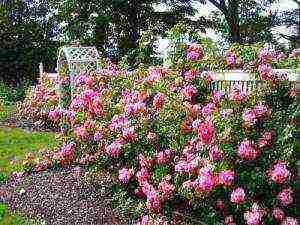 Rosary decoration
Rosary decoration
on your site. Read about this in our next article.
And this article tells about the types of mixborders. Photo.
Varieties for Russian gardens
- Buddley of David (remember a monk!) - a spreading shrub 2-3 meters high with drooping branch ends, it is successfully cultivated even in the northern regions of the Russian Federation.
- Buddley of David "Black Knight" - a powerful shrub no more than 2 meters in height with purple inflorescences in the form of sultans up to 30 cm. We tolerate partial shade, loves watering, tolerates winter well without shelter. Especially effective in tapeworms and group plantings.
- Buddley David "Nano Blue" - a deciduous shrub with a funnel-shaped crown, up to 1.5 meters high and wide. It is characterized by decorativeness of elongated leaves with a gray velvety back and bright violet-blue inflorescences, bending the ends of the branches to the ground. Demanding on sunlight and fertile soils.
- Buddleya David "Pink Delight" - a tall shrub (3 meters) with large pink erect spike-shaped inflorescences. Has a thick honey aroma. The crown that froze over the winter is completely replaced by new shoots in the spring; gives a 3-meter growth per season. Photophilous, prefers calcareous drained soil. It mixes well with herbaceous perennials and low shrubs.
- Buddleya David "Royal Red" - got its name from the color of drooping spike-shaped inflorescences (red-purple). At a height of 3 meters, it has a wide (up to 3 m) spreading crown; characterized by rapid growth and excellent ability to recover from freezing in the cold season. Grows well on neutral and calcareous soils, with sufficient drainage; requires sunlight and moisture.
- Buddleya David "Flower Power" - has another name - Bicolor (bicolor), since the flowers are of two colors - orange and purple. A tall, spreading shrub, but due to its heat-loving nature, it grows like a half-shrub in our latitudes. Fluffy, fragrant erect inflorescences reach 40cm in length. The reverse side of the leaves is white or yellow, pubescent. It begins to bloom from the second year. During the growing season, in the place of the frozen crown, it grows shoots up to 1.8 m. In general, winter-hardy.
Reproduction of Buddley David. Planting and leaving
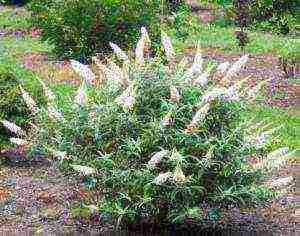 At home, buddleya successfully propagates by seeds, which are scattered by self-sowing. So, in South Africa, this feature of the shrub leads to an aggressive seizure of territory, it is worthwhile for only one plant to appear there. On the territory of Russia, due to its climatic conditions, a photophilous plant cannot always give ripe seeds before freezing. Therefore, in ornamental horticulture, along with seed planting, a method for propagating buddley by cuttings is common.
At home, buddleya successfully propagates by seeds, which are scattered by self-sowing. So, in South Africa, this feature of the shrub leads to an aggressive seizure of territory, it is worthwhile for only one plant to appear there. On the territory of Russia, due to its climatic conditions, a photophilous plant cannot always give ripe seeds before freezing. Therefore, in ornamental horticulture, along with seed planting, a method for propagating buddley by cuttings is common.
- Sowing seeds... The best time for this is late winter - early spring (February-March). In a well-drained and moistened planting substrate, with the addition of sand and humus in equal parts, seeds of buddley are sown, covering them with a thin layer (several mm) of soil.
- Vegetative propagation (cuttings)... Cuttings are harvested immediately after flowering (in the second half of September), 20 cm in size with the obligatory presence of 3 buds. The lower part of the cutting, with two buds, is buried in the loosened soil of the garden. For the winter, they are covered with a film and sprinkled with earth, leaving an air gap. The cuttings will grow in the spring, when the earth warms up well. During the season, they will grow by 60 cm, and even before the cold weather they can have time to bloom.
Video about growing Buddley David from seeds.
What drives growth

- Sufficient sunlight... This feature must be taken into account at the time of landing.
- Properly selected and cultivated soil... Desirable, lime, well-drained, with fertilizing with nitrogenous fertilizers twice a season - after winter and in the middle of summer. The growth and flowering are well influenced by fertilizers containing potassium and phosphorus, as well as organic fertilizing.
- Watering buddley must ensure that the soil is always moist, free from flooding. In addition, in the summer months, the crown of the bush is sprayed with water.
- Pruning... Regular pruning stimulates intense flowering and rejuvenation of the bush. In the first year of life, the buddley is cut to half in March, removing weak shoots. In the second year, new growths are cut off to 2 buds. And cut off a third of every old branch. Subsequently, pruning can be used to form the crown and remove young growths.
- Shelter for the winter... In cold climatic regions, buddley bushes require careful shelter from frost. This is done using film, dry leaves, peat and snow covering the planting site. Frozen branches are cut in the spring, and the crown is easily restored.
Worth knowing ...
- The seeds of buddleya fully ripen only in the southern regions of our country.
- When propagated by seeds, one may encounter a change in the varietal properties of buddley, which will not happen when propagated by cuttings.
- Cuttings cut in the fall can be stored in a cold, frost-free place until spring and when they are planted in the ground.
- You can also cut buddleya in early spring, during the period of the appearance of the first buds.
- Buddley can also be grown in flower pots for decorating loggias and terraces.
- Budleia bushes should be planted at a distance of at least 2 meters from each other, taking into account their growth.
Buddlea (lat. Buddleja) is a perennial shrub belonging to the flowering department, the dicotyledonous class, the order of the lucid-flowered, the family of vines, the genus Budley. Quite often, this graceful and vibrant plant can be seen in public gardens, in flower beds in city parks or in private gardens.
The Latin name "Buddleja" was given to the plant in the 18th century in honor of the British botanist Adam Buddle.
back to contents ↑ Buddley: description and photo.
The buddley shrub is a bit like terry lilac, especially its gorgeous inflorescences, consisting of small flowers collected in a panicle. The length of the inflorescences, depending on the buddley variety, varies from 20 to 45 centimeters. With careful care, warm climate and competent crown formation, the buddley bush reaches 2.5-3 meters in height. In areas with cold winters, it grows up to 1-2 meters, but this does not diminish its mesmerizing beauty. The buddley flower does not have a very pronounced aroma, but it is an excellent honey plant, therefore bees, butterflies or ladybugs constantly hover around it.
back to contents ↑ Buddleya: varieties and types.
According to its "birthplace", the buddley flower is exotic, and in its homeland in the tropics, this flowering shrub has more than 150 species. But in other climatic zones, its distribution and diversity is quite large.
There are many varieties of varieties and types of buddley. These flowers differ in the shape of the bush, the size and color of the inflorescences. The palette is very versatile: bright purple and pale pink, white and purple, lilac, red or light cream - buddleya will surely become a spectacular decoration of any landscape.
Here are some types and varieties of this beauty:
back to contents ↑ Buddleja David, buddleja davidii (lat. Buddleja davidii).
Buddleya of David is the most common type of Buddleya, native to the northern Chinese provinces. A very sprawling shrub, the flowers of which exude a pleasant scent with a light honey note. Buddleya David and its varieties are prized by landscape designers for the ease of bush formation, long flowering and the variety of colors that the plant brings to the garden.
Buddleya David has the following varieties:
- Buddley of David White Profusion (white trade) - shrub reaching 3 meters in height.Shoots are strewn with racemose inflorescences with white flowers and a yellow core. This buddleya blooms in July-October.
White Profusion variety
Variety White Profusion
- Buddleya David Royal Red (royal ed) - purple-red flowers of a rich shade are collected in inflorescences 25-35 cm long. The buddlea bush is quite sprawling, reaching a height of 2.5-3.5 m and a width of 2.5-3.5 m.
Royal Red variety (royal red)
- Buddleya of David Adonis Blue - a shrub with rich blue-purple fragrant inflorescences 25-30 cm long. The height of this variety of David's buddley is 120-150 cm.
Adonis Blue cultivar (adonis blue)
- Buddleya David Black Knight - purple flowers of an exceptionally dark shade and outstanding aroma are collected in inflorescences 25 cm long. An adult plant grows to a height of about 2-3 meters.
Black Knight variety
Black Knight variety
- Buddley of David Flower Power (flower power) originally from China. Shrub 2 meters high, inflorescence length 30 cm, flowers have a purple-orange hue. It tolerates cold weather well without shelter, it grows even in the northern regions of Russia. It blooms for 30-45 days from late summer and throughout the fall. Abundant and annual flowering from 3 years of age.
Flower Power cultivar
Flower Power variety
back to contents ↑ Buddleja alternifolia (lat. Buddleja alternifolia).
The homeland of this type of buddleya is the north of China. It grows in open areas and is a tall shrub about 4 meters in height with graceful spreading shoots. During the flowering period, the shoots are covered with small purple flowers. Alternate-leaved buddleya blooms in early summer for about 20-25 days. It grows quickly, does not require abundant watering, it tolerates drought very easily. Despite its southern origin, buddlea alternate-leaved belongs to frost-resistant plants. Due to its characteristics, it belongs to the most promising species for landscaping in the southern part of Russia.
back to contents ↑ Buddleja stenostachya (Latin Buddleja stenostachya).
Homeland - the mountainous regions of Western China. It is a shrub 3 meters high. This type of buddleya grows very quickly, blooming every year from early August to September. Like other species, this shrub attracts butterflies with its magnificent melliferous aroma. The flowers of the narrow-ear buddleia are small, lilac or purple in color. It blooms for a long time and abundantly. The plant tolerates frosts down to -20 degrees. A cold winter can damage the shrub, and then there will be no flowering in the spring. In Russia, this species can be grown only in the southern regions.
back to contents ↑ Buddleja globosa (Latin Buddleja globosa).
Almost evergreen shrub with bright yellow or orange buds and a very aromatic odor. An adult plant grows to a height of about 2 meters. It grows mainly in the southern regions of Russia, in the Crimea and the Caucasus. Does not tolerate cold winters.
back to contents ↑ Japanese buddleya (lat. Buddleja japonica).
The homeland of this species is Japan. It is a decorative deciduous shrub 2-3 meters high with wide spreading shoots. The flowers are lavender, collected in dense panicles up to 20 cm long. Blooms in May-June. This species is distinguished by rapid growth and winter hardiness up to -15 degrees. In Russia, this species is not in demand, in contrast to different varieties of David's buddlea and buddleya alternate-leaved.
back to contents ↑ Snow buddleya (lat. Buddleja nivea).
Snow buddleya is a rare species. Homeland is Japan. It is an ornamental deciduous shrub, height up to 3 meters, shoots pubescent over the entire surface. The flowers are lilac, small and pubescent, very fragrant. Inflorescences reach a length of 15 cm. The shrub blooms for 25-30 days in June-July. Snow buddleya is very thermophilic, therefore it is suitable for cultivation exclusively in the southern regions. At the same time, the shrub is resistant to diseases and unpretentious in care.
back to contents ↑ Buddleja albiflora (lat. Buddleja albiflora).
This look looks gorgeous in landscape design. The homeland of the shrub is Japan. Photophilous, drought-resistant, grows only in southern climates. It is a deciduous shrub up to 6 meters high with a dense and erect crown. The flowers are white, lilac or pale lilac, the throat is orange with a tube up to 8 mm long.Inflorescences are broad cone-shaped panicles up to 45 cm long. Blooms profusely and for a long time in July. Withstands frosts down to -23 degrees.
back to contents ↑ Buddley - planting and leaving.
Before planting a buddley, you should choose an ideal place for the shrub. Buddleya is responsive to light, loves space, but its rather fragile branches often suffer from gusts of wind.
- Planting buddley.
Before planting shrubs, planting pits should be fertilized with rotted manure, as well as phosphorus-potassium fertilizers and ash. Planting buddley is carried out in 2 ways: by seeds and cuttings. But regardless of which method you choose, the following steps should be followed:
- First, buddley (seeds or cuttings) are planted at home in pots or boxes in advance. This is done in February, so that by the spring the buddlei seedlings are strong and ready for planting in open ground.
- In the period from April to May, when the ground warms up enough, buddley seedlings are planted in open ground, it is more convenient to bury the plant in the ground along with a container so as not to damage the roots.
- In the land, buddleya grows before the onset of cold weather. Then the plant is dug up and placed in special containers, which should be kept in a cool place, for example, in a basement. To prevent moisture from evaporating, the container can be tightened with foil, leaving the plant itself free. Only adult plants, which are 2-3 years old, can be left in the ground for the winter period. Be careful - not only cold winters are more terrible, but also mild winters with frequent thaws, during which the bush can get wet.
- After wintering, in April-May, the buddlea is again ready for planting in open ground. If the flower is not planted in the ground, it will not have enough moisture in the summer, and frequent watering will be necessary.
- back to contents ↑ Buddley bush: going into intense heat.
In intense heat, the buddlea shrub needs good, but not excessive watering and additional spraying of the foliage. This procedure is performed in the evening after sunset. It is advisable to cover the soil around the buddleya with straw mulch or a layer of peat, which will optimally retain moisture.
- back to contents ↑ Buddley flower: pruning.
Pruning buddleya is mandatory, especially in the first year, and it is carried out in early spring (late March - early April). The main branches of the shrub are shortened by almost half, as a result, the flower gives a powerful growth of lateral shoots, pleases with lush forms and rich flowering. It should be remembered that such withdrawal is very important for the buddleya.
- back to contents ↑ Preparing the buddley for winter.
Unfortunately, the buddley bush is afraid of the cold: after all, it is a southern "inhabitant". This nuance requires the correct organization of the winter bush shelter. Before doing this, the buddley must be cut off. You should not be afraid if this is done very shortly: in the spring the plant will surprise you with its new, more luxurious crown. Then the buddley bush can be insulated with dry foliage, hay or sawdust, covered with a wooden box or other improvised structure on top.
back to contents ↑ Reproduction of buddley by cuttings.
Despite the fact that buddleya is an exotic plant, it reproduces quite easily. The easiest way to propagate a buddley flower is using the apical cuttings of an adult specimen. In the summer, in June-July, several young, strong shoots are cut off, the lower leaves are removed from them, the cutting is treated with a growth-stimulating composition. Then the prepared buddlea shoots are planted in loose soil, watered and covered with foil until rooting. This reproduction technique allows you to fully preserve all the species characteristics of a certain buddley variety.
back to contents ↑ Buddleya: growing from seeds.
Reproduction of the buddleya shrub by seeds is also possible, but this process is more laborious.At the beginning of spring, the seeds are sown in cups with a moistened peat mixture, covered with foil and removed to a warm place for 14-18 days before germination. The emerging sprouts should be ventilated, and the soil should be moistened once every 3 days. In the future, the matured and grown buddleya seedlings are planted in a permanent place.
back to contents ↑ Interesting Buddhist Facts:
- During the flowering period of buddleya, a warm sugar aroma emanates from the flowers, which is compared with the smell of hyacinths.
- Stem cells of the type of David's buddley are used in cosmetology as anti-stress agents.
Did you like the article? Share with your friends:
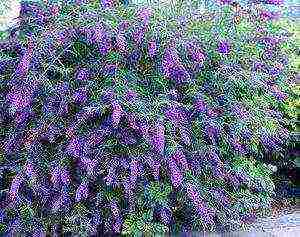 Exotic plants of the Buddleya genus grow in regions with tropical and subtropical climates. Shrubs amaze with their diversity, beauty and uniqueness. In nature, there are more than 100 species of Buddley, but only a few of them are widely used in ornamental gardening.
Exotic plants of the Buddleya genus grow in regions with tropical and subtropical climates. Shrubs amaze with their diversity, beauty and uniqueness. In nature, there are more than 100 species of Buddley, but only a few of them are widely used in ornamental gardening.
The sweetish smell of the plant constantly attracts a large variety of butterflies and other insects. Therefore, buddleya is often called a butterfly bush.
Budleya David: description
Budleya is rather attractive deciduous and evergreen plant with beautiful bright clusters. It can often be found in city parks, squares, garden plots and flower beds. In appearance, the buddleya resembles a lilac bush, which is especially emphasized by chic bunches gathered in a panicle and consisting of elongated inflorescences, the length of which is 20–45 cm.
Budley flowers of david - tubular, small, divided into 4 slices (like lilacs), have a variety of shades: from pastel-delicate, white tones to juicy, bright orange, lilac and crimson shades.
The fruits of the plant look like elongated capsules containing seeds, and they appear at the same time as flowers and buds. An adult plant can reach a height of up to three meters, however, in areas with a predominance of a cold climate, the buddlei bush grows no higher than 1–2 m. The shrub has spreading forms, blooms from July until late autumn. The length of the flowering period depends on the buddleya variety.
Same
Long flowering, as well as juicy bright colors and spreading forms, this exotic shrub has gained immense popularity among landscape designers.
Plants are planted, mostly singly, in order to draw attention to the luxurious form of the shrub. In addition, buddleya is widely used to create unique compositions with perennial and coniferous plants.
Gallery: buddleya David (25 photos)
Varieties and types of budley
In nature, there are a huge number of varieties and varieties of buddlei, differing among themselves in the variety of shapes and shades of inflorescences, the duration of the flowering period, as well as the shape and height of the bush.
Buddley of David
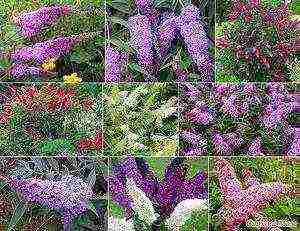 It is one of the most popular and widespread types of buddlei, suitable for growing in temperate regions. Buddley of David loves sunny places, prefers to grow in well-drained soils and open areas. The height of a plant of this species reaches 2-3 meters.
It is one of the most popular and widespread types of buddlei, suitable for growing in temperate regions. Buddley of David loves sunny places, prefers to grow in well-drained soils and open areas. The height of a plant of this species reaches 2-3 meters.
A characteristic feature of the variety is the rapid development of young shoots. The leaves are pointed towards the crown, have an ovate-lanceolate or lanceolate shape, their length is 25 cm. The inflorescences are lilac, about 40 cm long. Buddleya David blooms from late summer to late autumn. The flowering period lasts 1.5-2 months.
Buddleya David is classified into the following varieties:
- Buddleya David Royal Red... Sprawling bush up to three meters long with bright purple, very large inflorescences. Royal Red is considered the most aromatic and attractive variety, prefers to grow in open sunny areas. It blooms from the second half of summer to early autumn.
- Buddleya David Alba... It is a spreading (up to two meters) shrub characterized by rapid growth.White inflorescences are similar in shape to a pyramid. The peculiarity of this variety is the orange flower base, which is why the variety is sometimes called the orange eye. The flowering period is July-October.
- Buddleya David Black Knight... This variety got its name due to its special coloring - it has a dark purple hue, and inside the flower itself there is a speck of orange color. The shrub is tall, reaching a height of up to 3 meters. The plant is not afraid of drought and thrives in southern latitudes.
- Buddleya David Orchid beauty... A plant with delicate inflorescences of a pink-lilac shade. In our climate, it grows no more than 1.5 meters. Flowering lasts from August to September. The shrub tolerates pruning well.
- Buddleya david flower power... The homeland of this plant is China. The height of the shrub reaches two meters. Panicle-shaped inflorescences about 30 cm long are brightly colored in orange-purple tones. A bright, stunningly flowering bush can decorate any area or garden and give you an optimistic mood with its bright colors. The flowering period lasts up to 1.5 months. Buddleya blooms from late summer to autumn. A feature of the variety is frost resistance, the ability to withstand harsh climatic conditions, which makes it possible to grow this variety of Buddley in the northern regions.
- Buddley of David Harlequin Bush, with voluminous shapes and small inflorescences of a blue-violet hue up to 30 cm long. Harlequin inflorescences are excellent for cutting and look very impressive in bouquets. This is a light-loving variety that does not tolerate cold weather, therefore, in winter it needs a warm shelter.
David's buddley flower: planting, reproduction and care
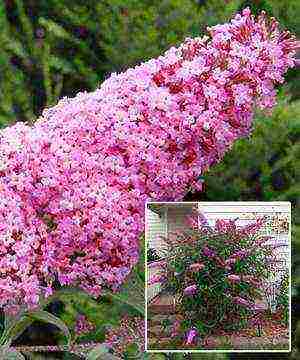 Optimal landing site David's budley is a sufficiently lit area of a vegetable garden or garden. It is necessary to plant a buddley bush at a fairly significant distance from other plants, preferably in a place sheltered from the wind. Buddleya David prefers moist and well-drained soil.
Optimal landing site David's budley is a sufficiently lit area of a vegetable garden or garden. It is necessary to plant a buddley bush at a fairly significant distance from other plants, preferably in a place sheltered from the wind. Buddleya David prefers moist and well-drained soil.
Planting cuttings or seeds for seedlings is carried out from the end of January to the beginning of February. After germination, the shoots dive into the pots and only in late spring - early summer, buddley is transferred to well-heated soil. The surface of the soil around the bush must be mulched using grass, peat or straw for this.
Despite the fact that the buddlea of David is a thermophilic exotic plant, it has quite easily adapted to our climate. True, its growth is not as high as that of its Chinese relatives.
Most varieties of David's buddley do not tolerate cold, therefore, shrubs should be covered in winter. But before that, it is necessary to make a short pruning of the plant, and only then build an appropriate shelter for it.
Pruning, watering
Planting and caring for David's buddley requires some knowledge, including the rules of regular pruning. Only if this procedure is adequately performed, a large number of inflorescences may appear, as well as abundant and prolonged flowering.
Caring for the shrub, everyone the gardener must perform the following types of work:
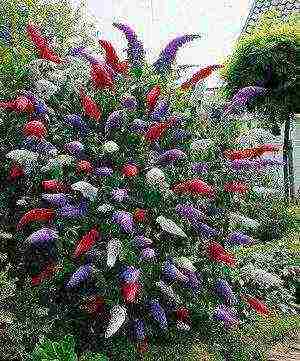 In the first year of the buddleya's life, the main branches are pruned. It is carried out literally immediately after planting the plant, while the main branches are cut to half. This will ensure the active development of young growth. Weak parts of the plant are removed. It is advisable to plan buddley pruning in March.
In the first year of the buddleya's life, the main branches are pruned. It is carried out literally immediately after planting the plant, while the main branches are cut to half. This will ensure the active development of young growth. Weak parts of the plant are removed. It is advisable to plan buddley pruning in March.- A year after the first pruning, it is necessary to prune last year's branches to the level of young ones, and also to shorten the grown growths by about two buds. In the case when the shrub is located in an open, windy place, the shoots are cut only by 1/3 in order to avoid breaking.
- The same pruning should be done in the third year of the plant's life. The growths formed in the lower part of the shrub can be left to shape or removed.
Buddleya David, like any plant, requires watering. This should be done in dry weather, while trying not to swamp the soil. In addition, the plant is very fond of spraying with plain water. This helps the Buddhist feel like home, where a tropical humid climate prevails.
Top dressing
Budlea, like most other plants needs additional nutrients.
- Immediately after the end of the winter season, after the appearance of the first buds, it is necessary to feed the plant. The best option would be to apply nitrogen fertilizers, which provide good nutrition and contribute to the recovery of the shrub after winter.
- The next time, fertilization should be applied in the middle of summer. The composition of top dressing must necessarily include potassium and phosphorus, which stimulate active growth and abundant gorgeous flowering.
In addition, David's buddleya needs substances such as ash, compost and humus. These components are considered organic fertilizers and are well suited for feeding shrubs.
Planting and breeding budley
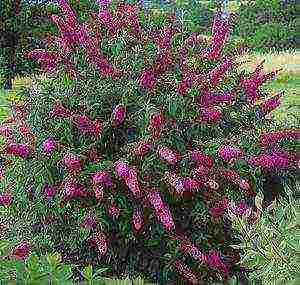 Reproduction of budley carried out by means of cuttings or seeds. The first ones must be cut off immediately after flowering, while the cuttings should have 3-4 buds.
Reproduction of budley carried out by means of cuttings or seeds. The first ones must be cut off immediately after flowering, while the cuttings should have 3-4 buds.
A shallow hole is made in the ground and a young shoot is lowered into it to the level of two buds. Then sprinkle the groove with crumbly soil. For the winter, cuttings, as well as adult plants, are covered.
With the onset of spring, intensive growth of young bushes begins. This happens only after the soil has completely warmed up. During this period, an immature plant needs special care... Otherwise, it can wither and even die.
Growing from seeds of David buddleya
The optimal period for growing a plant from seeds is February-March. First, it is necessary to well moisten and drain the planting substrate, and also add humus and sand to it in equal proportions. And only then can you start sowing seeds, sprinkling them with a thin layer of soil.
To make buddlea seeds germinate they should be covered with a film or glass container in order to create an optimal temperature regime (22-25 degrees). The first shoots will appear in 2 weeks. The greenhouse protection can be removed only after the first leaves appear.
As soon as the plant throws out the third leaf, the seedlings are transplanted in containers with peat. Seedlings are planted in the garden in July. If all these conditions are met, you will enjoy beautiful exotic flowers next year.
Winter buddlea care
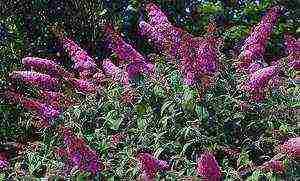 Preparing the plant for winter is an integral part of basic shrub care. Many gardeners prune the shrub to a height of 10 cm, and with the remaining leaves they line the area around the buddleya and additionally cover the shrub with humus or peat. However, this method has a significant drawback - in a too damp winter or on too warm winter days, the plant can steam up and die.
Preparing the plant for winter is an integral part of basic shrub care. Many gardeners prune the shrub to a height of 10 cm, and with the remaining leaves they line the area around the buddleya and additionally cover the shrub with humus or peat. However, this method has a significant drawback - in a too damp winter or on too warm winter days, the plant can steam up and die.
So how to properly prepare this thermophilic flower for wintering in the garden and take care of it during this period?
Tender young shoots of the bush are recommended by October cut almost to the root, leaving a small stump on the surface. In this case, it is very important to carefully cover and insulate the roots of the plant with peat or fallen leaves. And, of course, everyone knows the fact that the most reliable protection is snow cover.
Archival condition, which provides care for the buddleya in winter, is the addition of snow to the wintering bush.
In addition, special snow barriers can be built in the fall. It looks equally impressive both alone and in combination with other types of plants.
Whether to grow this chic shrub in his garden is up to every gardener himself.But if suddenly your choice falls on this exotic plant, you will definitely not regret it. After all, the buddleya will delight you with its flowering all autumn, precisely at the time when most of the trees and shrubs have already faded.
Attention, only TODAY!


